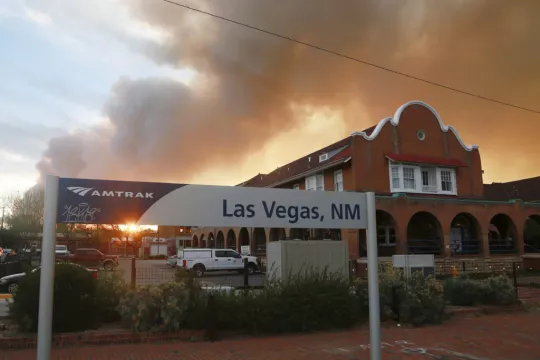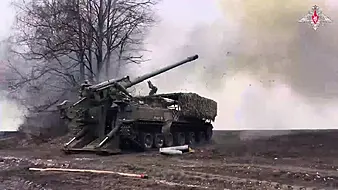Firefighters in New Mexico’s Rocky Mountain foothills have been preparing to excavate new firebreaks and clear brush to create more defensive lines aimed at preventing a massive wildfire from destroying more homes and tinder-dry pine forests.
The fire – the largest in the US – has burned about 300 homes and jumped a motorway late on Sunday, taking hold in rugged areas difficult for firefighters to reach and prompting a warning for more residents of rural villages to be ready to flee quickly.
Another New Mexico wildfire in the mountains surrounding one of the federal government’s key facilities for nuclear research prompted Los Alamos National Laboratory and community officials to prepare for possible evacuations.
Officials stressed there is no emergency but the fire is within about three miles of the lab and growing.
“If you don’t have to be at work, it’s time to prepare to telework,” lab director Thom Mason told employees in a video.
“Conditions can change quickly; it has been very dry, very windy, and we have to be respectful of that risk and ready for what comes next.”
There was no let-up on Monday to the gusty winds that have complicated firefighting efforts.
The wind has fanned the New Mexico fires for weeks, with only brief interruptions, and the most recent wave of consecutive days of extremely dangerous wildfire conditions are unprecedented, weather forecasters said.
Nearly 1,700 firefighters have been battling the biggest blaze burning north-east of Santa Fe, New Mexico.
It has charred more than 296 square miles, an area nearly the size of New York City.
After fighting it for nearly a month, firefighters had contained nearly half of the blaze by Monday, a feat that operations section chief Todd Abel said was significant given the challenges crews have faced.

The region’s largest population centre — Las Vegas, New Mexico, home to 13,000 people — has been declared largely safe from being burned after firefighters mostly stopped the fire on that front.
But thousands of people living in smaller, outlying communities are still under evacuation orders.
The northern and southern flanks of the wildfire have proven trickier to contain as wind gusts over the weekend topped 50mph.
Officials on Monday morning had not yet determined if it would be safe enough to launch aircraft to help with the firefighting effort.
The aircraft are used to drop water directly on flames or lay retardant ahead of the blaze’s expected direction so that bulldozers and ground crews can dig firebreaks in places where there are no roads, which act as firebreaks.
The National Interagency Fire Centre said more than 20,000 New Mexico structures have been threatened by the fire.
Authorities late on Sunday told residents in small villages on the northern front of the fire to evacuate, saying it was approaching quickly after jumping a road.

People who wait too long to leave could face life-threatening situations fleeing because of heavy smoke and congested roads, said Dave Bales, the incident commander of the team fighting the fire.
That sort of scenario makes the smoke “so thick you can’t see, you can’t drive, you can’t see the engine ahead of you”, he said.
The threatened communities are along a state highway that runs from Las Vegas, New Mexico, up to the Taos skiing and outdoor recreation resort.
Taos itself has not been threatened but people in some parts of Taos County have been told to prepare for possible evacuations.
Nationwide, three new large fires were reported over the weekend — two in Arizona and one in Texas.
The National Interagency Fire Centre reported on Monday that a dozen unconfined large fires have burned more than 503 square miles in four states so far this year.
Some 10 of these large fires and nearly all of the acres burned are in New Mexico and Arizona.
Wildfires have become a year-round threat in the drought-stricken West and are moving faster and burning hotter than ever due to climate change, scientists and fire experts have said.
Fire officials have also said that many forested areas have become overgrown and unhealthy and that the build-up of vegetation can worsen wildfire conditions.







